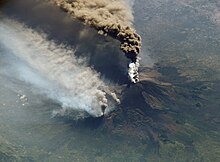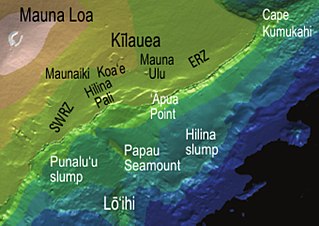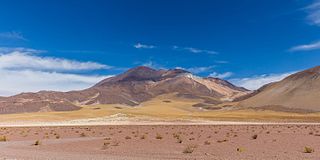
A flank eruption is a volcanic eruption which occurs on the flanks of a volcano, instead of at its summit. Such eruptions occur when the conduit connecting the summit to the magma chamber below is blocked, forcing the magma to move laterally.

A flank eruption is a volcanic eruption which occurs on the flanks of a volcano, instead of at its summit. Such eruptions occur when the conduit connecting the summit to the magma chamber below is blocked, forcing the magma to move laterally.
At some volcanoes, flank eruptions are common, and occur along clearly defined rift zones. This is the case at Mauna Loa and Kilauea volcanoes in Hawaii, Piton de la Fournaise on Reunion Island, [1] and Mount Etna in Italy. [2] Flank and summit eruptions may occur at the same time. [3]
Where there are inhabited areas on the flanks of a volcano, flank eruptions may be more destructive and dangerous than summit eruptions. [4] Flank eruptions may also trigger the collapse of the volcanic edifice, causing lateral eruptions (such as the 1980 eruption of Mount St. Helens), landslides and tsunamis. Collapse-drive eruptions are among the largest and most destructive volcanic phenomena. [5]
A caldera is a large cauldron-like hollow that forms shortly after the emptying of a magma chamber in a volcano eruption. When large volumes of magma are erupted over a short time, structural support for the rock above the magma chamber is gone. The ground surface then collapses into the emptied or partially emptied magma chamber, leaving a large depression at the surface. Although sometimes described as a crater, the feature is actually a type of sinkhole, as it is formed through subsidence and collapse rather than an explosion or impact. Compared to the thousands of volcanic eruptions that occur each century, the formation of a caldera is a rare event, occurring only a few times per century. Only seven caldera-forming collapses are known to have occurred between 1911 and 2016. More recently, a caldera collapse occurred at Kīlauea, Hawaii in 2018.

Mount Ruapehu is an active stratovolcano at the southern end of the Taupō Volcanic Zone and North Island volcanic plateau in New Zealand. It is 23 km (14 mi) northeast of Ohakune and 23 km (14 mi) southwest of the southern shore of Lake Taupō, within the Tongariro National Park. The North Island's major ski resorts and only glaciers are on its slopes.

Kīlauea is an active shield volcano in the Hawaiian Islands. Located along the southeastern shore of Hawai'i Island, the volcano is between 210,000 and 280,000 years old and emerged above sea level about 100,000 years ago. Historically, it is the most active of the five volcanoes that together form the island of Hawaii. Kīlauea is also one of the most active volcanoes on Earth, with the most recent eruption from June 7-19, 2023 after a series of earthquakes, when multiple vents erupted lava within Halemaʻumaʻu, a pit crater in the volcano's summit caldera, and building a fissure cinder cone approximately 40 m (130 ft) high. Halema'uma'u has been the sole eruptive area of Kīlauea since December 2020 with intermittent lava effusion from then to March 7, 2023, followed by a 90 day pause.

Piton de la Fournaise is a shield volcano on the eastern side of Réunion island in the Indian Ocean. It is currently one of the most active volcanoes in the world, along with Kīlauea in the Hawaiian Islands, Stromboli and Etna in Italy and Mount Erebus in Antarctica. A previous eruption began in August 2006 and ended in January 2007. The volcano erupted again in February 2007, on 21 September 2008, on 9 December 2010, which lasted for two days, and on 1 August 2015. The most recent eruption began on 2 July 2023. The volcano is located within Réunion National Park, a World Heritage Site.

The Hilina Slump, on the south flank of the Kīlauea Volcano on the southeast coast of the Big Island of Hawaiʻi, is the most notable of several landslides that ring each of the Hawaiian Islands. These landslides are the means by which material deposited at a volcano's vents are transferred downward and seaward, eventually spilling onto the seabed to broaden the island.

Lava lakes are large volumes of molten lava, usually basaltic, contained in a volcanic vent, crater, or broad depression. The term is used to describe both lava lakes that are wholly or partly molten and those that are solidified.

The Hōei eruption of Mount Fuji started on December 16, 1707 and ended on February 24, 1708. It was the last confirmed eruption of Mount Fuji, with three unconfirmed eruptions reported from 1708 to 1854. It is well known for the immense ash-fall it produced over eastern Japan, and subsequent landslides and starvation across the country. Hokusai's One Hundred Views of Mount Fuji includes an image of the small crater at a secondary eruption site on the southwestern slope. The area where the eruption occurred is called Mount Hōei because it occurred in the fourth year of the Hōei era. Today, the crater of the main eruption can be visited from the Fujinomiya or Gotemba Trails on Mount Fuji.

Kambalny is a stratovolcano located in the southern part of the Kamchatka Peninsula, Russia. It is the southernmost active volcano of Kamchatka. It has erupted mafic rocks. It has a summit crater as well as five cinder cones on its flanks which are the source of lava flows.

A rift zone is a feature of some volcanoes, especially shield volcanoes, in which a set of linear cracks develops in a volcanic edifice, typically forming into two or three well-defined regions along the flanks of the vent. Believed to be primarily caused by internal and gravitational stresses generated by magma emplacement within and across various regions of the volcano, rift zones allow the intrusion of magmatic dykes into the slopes of the volcano itself. The addition of these magmatic materials usually contributes to the further rifting of the slope, in addition to generating fissure eruptions from those dykes that reach the surface. It is the grouping of these fissures, and the dykes that feed them, that serves to delineate where and whether a rift zone is to be defined. The accumulated lava of repeated eruptions from rift zones along with the endogenous growth created by magma intrusions causes these volcanoes to have an elongated shape. Perhaps the best example of this is Mauna Loa, which in Hawaiian means "long mountain", and which features two very well defined rift zones extending tens of kilometers outward from the central vent.

Several types of volcanic eruptions—during which lava, tephra, and assorted gases are expelled from a volcanic vent or fissure—have been distinguished by volcanologists. These are often named after famous volcanoes where that type of behavior has been observed. Some volcanoes may exhibit only one characteristic type of eruption during a period of activity, while others may display an entire sequence of types all in one eruptive series.

Cerro del Azufre is a stratovolcano located in El Loa Province, Antofagasta Region, Chile. It is part of a chain of volcanoes that separate Upper Loa River basin from Salar de Ascotán basin and is flanked to the west by a dacitic lava dome called Chanka or Pabellón. The 6000 metre volcanoes San Pedro and San Pablo are located to the southwest of Cerro del Azufre.

Lava is molten or partially molten rock (magma) that has been expelled from the interior of a terrestrial planet or a moon onto its surface. Lava may be erupted at a volcano or through a fracture in the crust, on land or underwater, usually at temperatures from 800 to 1,200 °C. The volcanic rock resulting from subsequent cooling is also often called lava.

A lateral eruption or lateral blast is a volcanic eruption which is directed laterally from a volcano rather than upwards from the summit. Lateral eruptions are caused by the outward expansion of flanks due to rising magma. Breaking occurs at the flanks of volcanoes making it easier for magma to flow outward. As magma is pushed upward towards the volcano it diverges towards the flanks before it has a chance to erupt from the crater. When the expanding flank finally gives it releases a flow of magma. More explosive lateral eruptions are referred to as lateral blasts. Some of the most notable examples of a lateral eruption include Mount St. Helens, Mount Pelée, and Mount Etna.
The magma supply rate measures the production rate of magma at a volcano. Global magma production rates on Earth are about 20–25 cubic kilometres per year (4.8–6.0 cu mi/a).

A multi-component gas analyzer system (Multi-GAS) is an instrument package used to take real-time high-resolution measurements of volcanic gases. A Multi-GAS package includes an infrared spectrometer for CO2, two electrochemical sensors for SO2 and H2S, and pressure–temperature–humidity sensors, all in a weatherproof box. The system can be used for individual surveys or set up as permanent stations connected to radio transmitters for transmission of data from remote locations. The instrument package is portable, and its operation and data analysis are simple enough to be conducted by non-specialists.
Réunion is a mafic island formed as a result of the Réunion hotspot in the Indian Ocean, the same hotspot that produced the massive basalt flows of the Deccan Traps, when it was beneath India more than 66 million years ago.

A sector collapse or lateral collapse is the structural failure and subsequent collapse of part of a volcano. Unlike a flank collapse, a sector collapse involves the central volcanic pipe. Sector collapses are one of the most hazardous volcanic events, often resulting in lateral blasts, landslides, and changes in volcanic eruptive behavior. Sector collapse can be caused by earthquakes, volcanic eruptions, gradual volcanic deformation, and other processes. Sector collapse events can occur on volcanoes present at both convergent and divergent plate boundaries. Sector collapses are generally very sudden; however, some attempts have been made to predict collapse events.

The 1669 eruption of Mount Etna is the largest-recorded historical eruption of the volcano on the east coast of Sicily, Italy. After several weeks of increasing seismic activity that damaged the town of Nicolosi and other settlements, an eruption fissure opened on the southeastern flank of Etna during the night of 10–11 March. Several more fissures became active during 11 March, erupting pyroclastics and tephra that fell over Sicily and accumulated to form the Monti Rossi scoria cone.
Idunn Mons is a shield volcano on the planet Venus. It is named after Iðunn, a goddess in Norse mythology.

The Cascade Volcanic Arc is a chain of volcanoes stretching from southern British Columbia down to northern California. Within the arc there is a variety of stratovolcanoes like Mount Rainier and broad shield volcanoes like Medicine Lake. But calderas are very rare in the Cascades, with very few forming over the 39 million year lifespan of the arc.